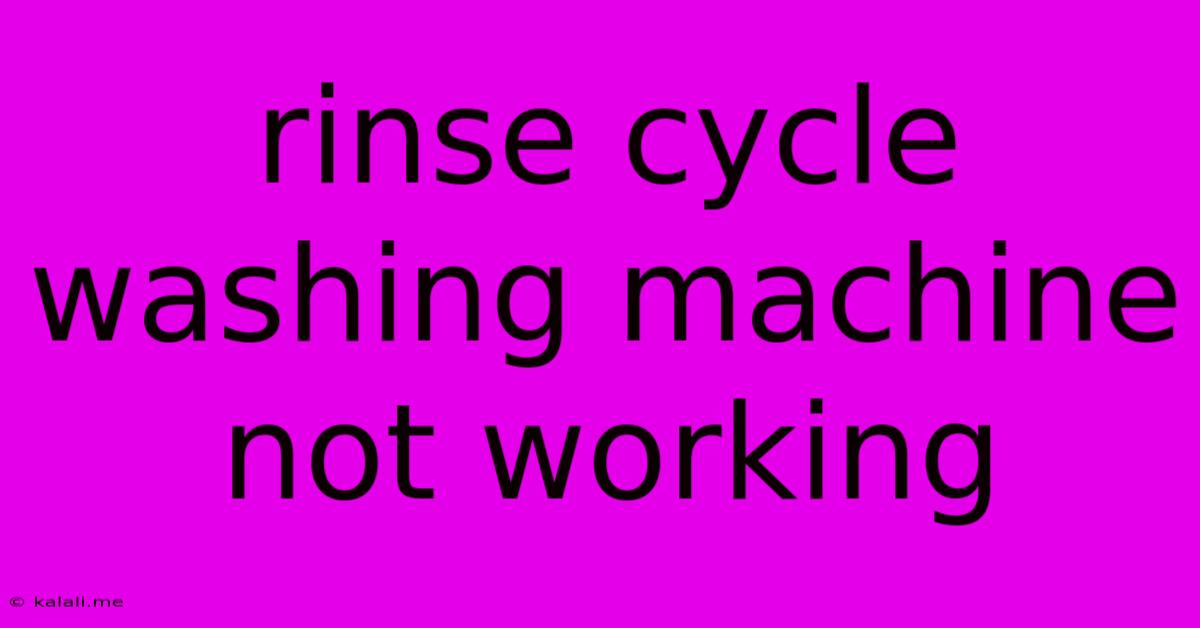Rinse Cycle Washing Machine Not Working
Kalali
Jun 02, 2025 · 3 min read

Table of Contents
Rinse Cycle Washing Machine Not Working: Troubleshooting and Solutions
Is your washing machine failing to rinse your clothes properly? A malfunctioning rinse cycle can leave clothes stiff, soapy, and generally unpleasant. This article will guide you through troubleshooting common causes of a non-functioning rinse cycle and offer solutions to get your laundry back on track. We'll cover everything from simple checks to more involved repairs, so let's dive in!
Common Causes of a Faulty Rinse Cycle:
Several factors can contribute to a washing machine's inability to complete a proper rinse cycle. These issues range from simple user errors to more complex mechanical or electrical problems. Let's explore some of the most frequent culprits:
- Clogged Inlet Hose: A clogged inlet hose restricts water flow into the machine, preventing sufficient water from entering for the rinse cycle. Check for kinks, blockages, or low water pressure.
- Faulty Water Inlet Valve: This valve controls water flow into the washing machine. A malfunctioning valve may fail to open completely, limiting water intake during the rinse. This is a more serious problem often requiring repair or replacement.
- Blocked Drain Hose: A blocked drain hose hinders the proper drainage of soapy water, preventing the machine from filling with fresh water for the rinse. Check for clogs and ensure the hose is correctly installed.
- Malfunctioning Pressure Switch: This component monitors water levels within the machine. If the pressure switch is faulty, the machine may not accurately sense the water level, leading to insufficient water for the rinse cycle.
- Defective Rinse Pump: The rinse pump is responsible for circulating water during the rinse cycle. A broken or faulty pump will prevent proper rinsing. This often requires professional repair.
- Incorrect Water Level Selection: Double-check that you've selected the appropriate water level for your load size. Insufficient water can lead to inadequate rinsing.
- Software Glitch: Modern washing machines utilize sophisticated computer systems. A software glitch could potentially disrupt the rinse cycle. Sometimes, simply unplugging the machine for a few minutes can reset the system.
- Faulty Control Board: This is the "brain" of your washing machine. A damaged control board will prevent the machine from properly executing programmed functions, including the rinse cycle. This usually necessitates professional repair or replacement.
Troubleshooting Steps:
Before calling a repair technician, try these troubleshooting steps:
- Check the Inlet Hose: Inspect the inlet hose for any kinks, bends, or blockages. Ensure it's securely connected to both the washing machine and the water supply.
- Check the Drain Hose: Ensure the drain hose isn't kinked or clogged. Also, verify the drain hose is positioned correctly, avoiding any obstructions that could hinder drainage.
- Inspect the Water Pressure: Low water pressure can prevent the machine from filling adequately. Check the water pressure in other areas of your home to rule out a wider issue.
- Check the Water Level Selection: Ensure you've selected an appropriate water level for your load size. Too little water will lead to poor rinsing.
- Clean the Lint Filter: A clogged lint filter can indirectly affect the rinse cycle. Ensure it's clean and clear.
- Power Cycle the Machine: Unplug the washing machine from the power outlet, wait a few minutes, then plug it back in. This can sometimes resolve temporary software glitches.
When to Call a Professional:
If the troubleshooting steps don't resolve the issue, it's likely a more serious problem requiring professional assistance. These include:
- Faulty water inlet valve
- Defective rinse pump
- Malfunctioning pressure switch
- Damaged control board
A qualified appliance repair technician possesses the expertise and tools to diagnose and repair these complex issues safely and efficiently.
Prevention is Key:
Regular maintenance can help prevent future rinse cycle problems. This includes:
- Regularly checking and cleaning the lint filter
- Periodically inspecting the inlet and drain hoses for clogs
- Ensuring proper water pressure
- Avoiding overloading the washing machine
By following these troubleshooting steps and preventative measures, you can effectively address most rinse cycle problems and keep your washing machine running smoothly. Remember, addressing minor issues early can often prevent more significant and costly repairs down the line.
Latest Posts
Latest Posts
-
How To Remove A Scratch On Plastic
Jun 03, 2025
-
How To Clean A Stinky Sink Drain
Jun 03, 2025
-
Smoke Detector Beeping After Changing Battery
Jun 03, 2025
-
Why Does My Furnace Keep Shutting Off
Jun 03, 2025
-
Is Naoh A Acid Or Base
Jun 03, 2025
Related Post
Thank you for visiting our website which covers about Rinse Cycle Washing Machine Not Working . We hope the information provided has been useful to you. Feel free to contact us if you have any questions or need further assistance. See you next time and don't miss to bookmark.